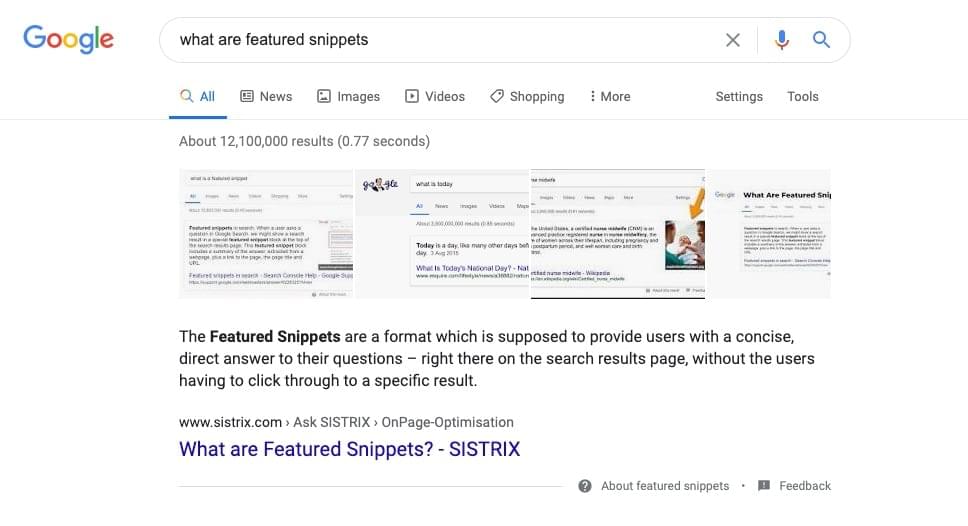
Search engine optimization (SEO) has evolved over the years. In addition to ranking your website for textual searches, you can now rank it for voice searches.
Google, for example, supports voice searches via Google Assistant. Google Assistant is a voice assistant that comes pre-installed on over 1 billion devices, according to the Mountain View-based tech company. Users can speak a search query into their device’s microphone to find content on the Internet.
By ranking your website for Google Assistant, you can reach users of these devices while potentially capturing them as customers in the process.
Aim for Featured Snippets

You should aim for featured snippets when optimizing your website for Google Assistant.
Also known as answer boxes, Google Assistant prioritizes featured snippets over all other listings. If there’s a featured snippet for a user’s search query, Google Assistant will choose it.
Google Assistant will speak the description text within the featured snippet in response to the user’s search query.
Featured snippets are considered organic listings, but they use a different format than other organic listings. They contain a long description, followed by a standard-length title below.
Google will typically display no more than a single featured snippet for any query.
Ranking your website in these featured snippets will ensure that it ranks for Google Assistant as well.
Brainstorm Questions

Brainstorming questions is an essential step to ranking with Google Assistant.
According to a survey conducted by Adobe Analytics, over half of all voice assistant users ask questions. When performing a search with Google Assistant, most users will format their speech-based query as a question.
Since most Google Assistant searches are questions, you’ll need to brainstorm questions to rank your website for them.
To brainstorm questions for your Google Assistant SEO efforts, consider the following tips:
- Review your website’s Google Search Console account to find questions for which it already ranks.
- Read emails sent by your website’s visitors while looking for common questions.
- Plug some of your website’s primary SEO keywords into Answer The Public.
- Use the autocomplete suggestions tool on Google to find questions containing SEO keywords.
- Use a traditional keyword research tool like Ahref’s Keyword Explorer or Google Ads Keyword Planner.
Publish High-Quality Answers

After brainstorming questions, you can publish answers to them on your website. For each question, you should create a new page focusing on an answer.
If Google Assistant believes a page has the best answer to a question, it will choose that page.
Your answers should be thorough and descriptive but also concise. PagesIn WordPress, a page is a content type that is used to create non-dynamic pages on a website. Pages are typica... More with bloated answers probably won’t rank—at least not for Google Assistant.
Google Assistant prefers pages with concise answers. By eliminating unnecessary words and filler from your answers, your pages will be more likely to rank for Google Assistant.
Just remember to create the best possible answers while keeping them relatively short and concise.
Add Images

Even though Google Assistant isn’t capable of displaying them, images can improve your website’s ability to rank for Google Assistant.
Pages with images are more likely to rank in featured snippets than those without images. And because Google Assistant prioritizes featured snippets, images are useful for Google Assistant SEO.
You can either create your own images to use on your website, or you can download them from a stock photo platform. There are free and paid stock photo platforms. Even the free platforms like Pixabay and Flickr offer tens of thousands of images.
Adding just one or two relevant images to each page will better align your website for Google Assistant.
Optimize for Natural Language

It’s important to optimize your answers for natural language. In other words, write your answers as if you were having a one-on-one conversation with another person.
Google states that over two-thirds of Assistant commands are performed in natural language.
By following this same conventional style with your answers, you’ll have an easier time ranking your website for Google Assistant.
Lock Down Your Website With HTTPS

Upgrading your website’s security with SSL/HTTPS will improve its Google Assistant rankings.
HTTPS is an encryption protocol that’s designed to protect against data breaches and other cyber threats. Google has used it in its ranking algorithm since 2014.
To upgrade your website with HTTPS, you’ll need to install an SSL certificate, which will allow your site to encrypt outgoing and incoming traffic and deliver your content over HTTPS. As a result, your website will be primed to rank higher for all Google searches, including those performed with Google Assistant.
Some web hosting services now offer free, easy-to-install SSL certificates. If you’re looking for a solid recommendation, check out our top picks here.
Refine the Title Tags

Refining the title tagsIn WordPress, tags are a taxonomy used to classify and organize posts. They are similar to categories, but unl... More of your pages can help them rank for Google Assistant.
The title tag dictates what appears in your browser tab when you visit a page. It’s also used by search engines as the main title for organic listings.
The title tag of a page should reflect the question for which it’s optimized to rank.
Google Assistant users typically won’t see or hear the title tag itself, but if a page’s title tag matches a user’s search query, Google Assistant may select it.
Along with publishing high-quality answers, refining your page’s title tags will help you succeed at Google Assistant SEO.
If you use WordPress, you can manage the title tags of your postsA post is a type of content in WordPress, a popular open-source content management system used for creating an... More and pages with the free Yoast SEO pluginA plugin is a software component that adds specific features and functionality to your WordPress website. Esse... More.
Don’t worry about refining your pages’ meta descriptions, as they have little or no influence over Google Assistant rankings. For featured snippets, Google Assistant will read the text within the listing’s long description; it won’t read the meta description.
Final Thoughts
Google Assistant SEO requires a different approach than conventional SEO.
Like all voice assistants, Google Assistant returns results using AI-driven speech. It will typically select a featured snippet if there’s one available. If there’s no featured snippet for a user’s search query, Google Assistant will select an excerptIn WordPress, an excerpt is a summary or brief description of a post's content. It is typically used to provid... More from a traditional listing.
If you have a WordPress site and want to grow your organic traffic, you’ll definitely want to check out our free WordPress SEO tutorial here. 👈
In the meantime, if you have any questions about Google Assistant SEO, feel free to leave them in the commentsComments are a feature of WordPress that allow users to engage in discussions about the content of a website. ... More below!



